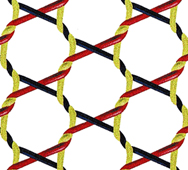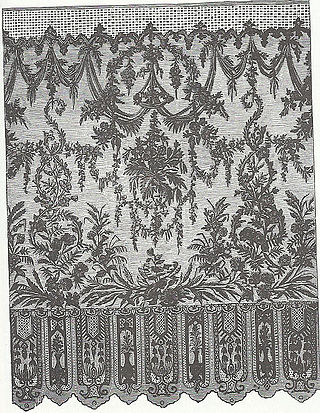
Lace is a delicate fabric made of yarn or thread in an open weblike pattern, made by machine or by hand. Generally, lace is divided into two main categories, needlelace and bobbin lace, although there are other types of lace, such as knitted or crocheted lace. Other laces such as these are considered as a category of their specific craft. Knitted lace, therefore, is an example of knitting. This article considers both needle lace and bobbin lace.

Bobbin lace is a lace textile made by braiding and twisting lengths of thread, which are wound on bobbins to manage them. As the work progresses, the weaving is held in place with pins set in a lace pillow, the placement of the pins usually determined by a pattern or pricking pinned on the pillow.

A bobbin or spool is a spindle or cylinder, with or without flanges, on which yarn, thread, wire, tape or film is wound. Bobbins are typically found in industrial textile machinery, as well as in sewing machines, fishing reels, tape measures, film rolls, cassette tapes, within electronic and electrical equipment, and for various other applications.

Bobbinet tulle or genuine tulle is a specific type of tulle which has been made in the United Kingdom since the invention of the bobbinet machine. John Heathcoat coined the term "bobbin net", or bobbinet as it is spelled today, to distinguish this machine-made tulle from the handmade "pillow lace", produced using a lace pillow to create bobbin lace. Machines based on his original designs are still in operation today producing fabrics in Perry Street, Chard, Somerset, UK.

Brussels lace is a type of pillow lace that originated in and around Brussels. The term "Brussels lace" has been broadly used for any lace from Brussels; however, strictly interpreted, the term refers to bobbin lace, in which the pattern is made first, and the ground, or réseau added, also using bobbin lace. Brussels lace is not to be confused with Brussels point, which is a type of needle lace, though sometimes also called "Brussels lace".

Torchon lace is a bobbin lace that was made all over Europe. It is continuous, with the pattern made at the same time as the ground. Torchon lace is notable for being coarse and strong, as well as its simple geometric patterns and straight lines. It does not use representational designs. Torchon lace was used by the middle classes for edging or insertion, and also to trim cotton and linen underwear, where it was ideal because of its strength and because it was inexpensive. Torchon lace was originally made from flax, but cotton is used as well, and has been for a long time. It is made in strips 1 to 2 inches wide. Torchon lace generally has a gimp outlining the pattern. The gimp was first used in Sweden, but now is used generally. Colored threads are occasionally used, but in general Torchon lace is white.

Battenberg lace is a type of tape lace. It is of American origin, designed and first made by Sara Hadley of New York. This American lace was named either in honor of the wedding of Princess Beatrice, Queen Victoria's youngest daughter, to Prince Henry of Battenberg, or from the widowed Princess Beatrice. It is made using bobbins and needles, or just needles alone.The original Battenberg lace used just one stitich: buttonhole picot. Other stitches that were later used include flat wheel and rings or "buttons).

Lace machines took over the commercial manufacture of lace during the nineteenth century.

Maltese lace is a style of bobbin lace made in Malta. It is a guipure style of lace. It is worked as a continuous width on a tall, thin, upright lace pillow. Bigger pieces are made of two or more parts sewn together.

Cluny lace is a bobbin lace style, worked as a continuous piece. It is a heavy plaited lace of geometric design, often with radiating thin, pointed wheatears. It is a guipure style of lace.

Tape lace is made with a straight tape which is bent into the shape required and sewn into position. Various needle lace fillings may be used to fill the gaps. The tape is usually machine made. This type of lace is also known as mixed tape lace, or mixed lace, as it uses more than one technique: one in making the tape, and a different technique for the fillings and joins.

Part lace or sectional lace is a way of making bobbin lace. It characterises various styles, such as Honiton lace or Brussels lace.

Russian lace is a bobbin tape lace. The tape is made with bobbins at the same time as the rest of the lace, curving back on itself, and joined using a crochet hook. It was made in Russia, but similar laces made elsewhere are also called Russian lace.

Bayeux lace was bobbin lace that was made at Bayeux in Normandy, France.

Idrija lace is a bobbin tape lace. The tape is made with bobbins at the same time as the rest of the lace, curving back on itself, and joined using a crochet hook.
Schneeberg lace is a bobbin tape lace. The tape is made with bobbins at the same time as the rest of the lace, curving back on itself, and joined using a crochet hook. This type of lace is developed about 1910 in Schneeberg.

Rosaline lace is a late 17th-century Venetian needle lace, and a late 19th-century bobbin part lace imitation. A Brussels variant with needle lace pearls is called Rosaline Perlée. The variant made in Bruges lacked the pearls.

The Leavers machine is a lacemaking machine that John Levers adapted from Heathcoat's Old Loughborough machine. It was made in Nottingham in 1813. The name of the machine was the Leavers machine. The original machine made net but it was discovered that the Jacquard apparatus could be adapted to it. From 1841 lace complete with pattern, net and outline could be made on the Leavers machine.
The Pusher machine was a lace making machine, based on the bobbinet, that was invented in 1812 Samuel Clark and James Mart.

Ipswich lace is a historical fashion accessory, the only known American hand-made bobbin lace to be commercially produced. Centered in the coastal town of Ipswich, Massachusetts north of Boston, a community of lacemaking arose in the 18th century. Puritan settlers to the area likely made and wore lace as early as 1634, because Sumptuary laws from the early colonial records indicate this activity. Earliest known records of the commercial production indicate that lace produced by local women was used to barter for goods in the 1760s, as denoted by ledger account books belonging to local merchants. These laces were sold in the region from Boston to Maine.



















